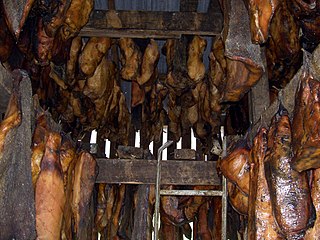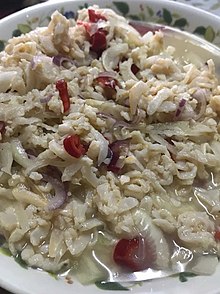
Sushi is a Japanese dish of prepared vinegared rice, usually with some sugar and salt, plus a variety of ingredients, such as vegetables, and any meat, but most commonly seafood. Styles of sushi and its presentation vary widely, but the one key ingredient is "sushi rice", also referred to as shari (しゃり), or sumeshi (酢飯).

Sashimi is a Japanese delicacy consisting of fresh raw fish or meat sliced into thin pieces and often eaten with soy sauce.

Ceviche, cebiche, sebiche, or seviche is a dish consisting of fish or shellfish marinated in citrus and seasonings, recognized by UNESCO as an expression of Peruvian traditional cuisine and Intangible Cultural Heritage of Humanity, although different versions of ceviche are part of the culinary culture of various Spanish-American countries along the Pacific Ocean where each one is native: Chile, Colombia, Costa Rica, Ecuador, El Salvador, Guatemala, Honduras, Mexico, Nicaragua, Panama and Peru. In Peru it is also considered a flagship dish and cultural heritage.

Carpaccio is a dish of meat or fish, thinly sliced or pounded thin, and served raw, typically as an appetizer. It was invented in 1963 by Giuseppe Cipriani from Harry's Bar in Venice, Italy, and popularised during the second half of the twentieth century. The beef was served with lemon, olive oil, and white truffle or Parmesan cheese. Later, the term was extended to dishes containing other raw meats or fish, thinly sliced and served with lemon or vinegar, olive oil, salt and ground pepper, and fruits such as mango or pineapple.

Malaysian cuisine consists of cooking traditions and practices found in Malaysia, and reflects the multi-ethnic makeup of its population. The vast majority of Malaysia's population can roughly be divided among three major ethnic groups: Malays, Chinese and Indians. The remainder consists of the indigenous peoples of Sabah and Sarawak in East Malaysia, the Orang Asli of Peninsular Malaysia, the Peranakan and Eurasian creole communities, as well as a significant number of foreign workers and expatriates.

Laab / Larb is a type of Lao meat salad that is the national dish of Laos, along with green papaya salad and sticky rice. Laab in the Lao language is a noun that refers to meat or other flesh that has been finely chopped and pounded. It is also considered a food of good luck in both Laos and Thailand because it has homonyms that mean 'lucky' in both languages, derived from लाभ in Sanskrit. Laab is of Lao origin, but is also eaten in other regions, most prominently the neighboring former Lan Xang territory, or modern day Laos and the northeastern and northern areas of Thailand, Isan and Lanna where the Lao have extended their influence. Other local variants of laab also feature in the cuisines of the Tai peoples of Shan State, Burma, and Yunnan Province, China.

Hákarl, referred to as fermented shark in English, is a national dish of Iceland consisting of Greenland shark or other sleeper shark that has been cured with a particular fermentation process and hung to dry for four to five months. It has a strong ammonia-rich smell and fishy taste, making hákarl an acquired taste.

A raw bar is a small restaurant or a bar within a restaurant where live shellfish are shucked and served. Raw bars typically offer a variety of raw and cooked seafood and shellfish that is served cold. Seafood-based dishes may also be offered, and additional, non-seafood foods may also be part of the fare. Raw bars may offer alcoholic beverages such as oyster shooters, as well as wine and sake that is paired with various foods. Additional accompaniments may include condiments, sauces and foods such as lemon and lime. Several restaurants in the United States offer raw bars, some of which are seasonal.

Odia cuisine is the cuisine of the Indian state of Odisha. Compared to other regional Indian cuisines, Odia cuisine uses less oil and is less spicy, while nonetheless remaining flavourful. Rice is the staple food of this region. Mustard oil is used in some dishes as the cooking medium, but ghee is preferred in temples. Odia foods traditionally served either on brass, bronze metal plates, banana leaf or disposable plates made of sal leaves.

Poke is a dish of diced raw fish tossed in sauce and served either as an appetizer or a main course.

Tiết canh is a Vietnamese dish of raw blood pudding served with cooked meat in Northern Vietnam. Pork and duck are the most common animal used to create this raw blood pudding. The most popular is tiết canh vịt, made from freshly killed duck blood, pork and chicken.

Kinilaw is a raw seafood dish and preparation method native to the Philippines. It is sometimes also referred to as Philippine ceviche due to its similarity to the Latin American dish ceviche. It is more accurately a cooking process that relies on vinegar and acidic fruit juices to denature the ingredients, rather than a dish, as it can also be used to prepare meat and vegetables. Kinilaw dishes are usually eaten as appetizers before a meal, or as finger food with alcoholic drinks. Kinilaw is also sometimes called kilawin, especially in the northern Philippines, but the term kilawin more commonly applies to a similar lightly grilled meat dish.

ʻOta ʻika is a Oceanian dish consisting of raw fish marinated in citrus juice and coconut milk. The Tongan, Tahitian, and Samoan variants are essentially identical in that the raw fish is briefly marinated in lemon or lime juice until the surface of the flesh becomes opaque. The fish is then mixed with coconut milk and diced vegetables. This is the national dish of Tonga.

Some species of jellyfish are suitable for human consumption and are used as a source of food and as an ingredient in various dishes. Edible jellyfish is a seafood that is harvested and consumed in several East and Southeast Asian countries, and in some Asian countries it is considered to be a delicacy. Edible jellyfish is often processed into a dried product. Several types of foods and dishes may be prepared with edible jellyfish, including salads, sushi, noodles, and main courses. Various preparation methods exist.

Sambal is an Indonesian chili sauce or paste, typically made from a mixture of a variety of chilli peppers with secondary ingredients such as shrimp paste, garlic, ginger, shallot, scallion, palm sugar, and lime juice. Sambal is an Indonesian loanword of Javanese origin. It originated from the culinary traditions of Indonesia and is also an integral part of the cuisines of Singapore, Malaysia, Brunei, and Sri Lanka. It has also spread through overseas Indonesian populations to the Netherlands and Suriname.

Sarawakian cuisine is a regional cuisine of Malaysia. Like the rest of Malaysian cuisine, Sarawak food is based on staples such as rice. There is also a great variety of other ingredients and food preparations due to the influence of the state's varied geography and indigenous cultures quite distinct from the regional cuisines of the Peninsular Malaysia. Sarawak is famous for its multi-ethnic population. As the homeland of many unique communities, Sarawak has a variety of cuisines rarely found elsewhere in Malaysia. The uniqueness of Sarawak well depends on its ethnic groups. Every native group in Sarawak has their own lifestyle, traditions, cultures and also foods. Sarawak cuisine is less spicy and has a subtle in taste. It uses fresh seafood and natural herbs like turmeric, lemongrass, ginger, lime and tapioca leaves. These ingredients are not only easily available, but also add a hint of aroma, texture and freshness to the delicacies. Food is one of the most cultural identities for native groups in Sarawak with each ethnic group having their own delicacies. Among the Iban, popular foods include tubu (stems), tuak and pansuh. The Malay have bubur pedas (porridge) and kek lapis Sarawak ; the Bidayuh have asam siok and sup ponas Bidayuh. The Melanau make tebaloi, sagu and umai and the Orang Ulu are known for garam barrio, kikid (broth), tengayen, and urum giruq (pudding).
















